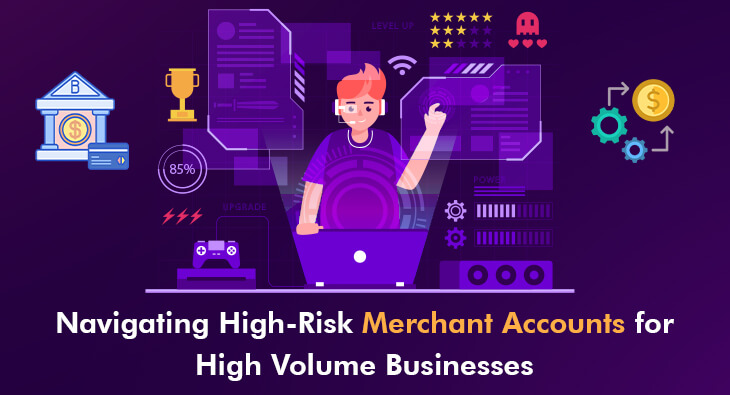In today’s dynamic market environment, Merchant Accounts >for High Volume Businesses serve as the backbone of financial transactions, empowering organizations to process payments efficiently and securely. However, certain businesses, due to the nature of their operations, volume of transactions, or the industries they belong to, are categorized as high-risk.
This classification can significantly affect their ability to obtain and maintain merchant accounts crucial for their survival and growth. In this blog post, we will navigate through the complexities of high-risk merchant accounts for high-volume businesses. Uncovering the challenges and opportunities that lie within.
Understanding High-Risk Merchant Accounts
High-risk merchant accounts cater to businesses perceived as having a higher likelihood of chargebacks, fraud, or other financial risks by payment processors. This perception stems from various factors, including the business model, transaction frequency, average transaction size, and the industry’s reputation.
For instance, companies operating in sectors like online gambling, adult entertainment, and cryptocurrency trading are automatically classified as high-risk.
Similarly, enterprises with large volumes of transactions, regardless of their domain, are tagged as high-risk due to the potential for a higher number of disputed transactions. These accounts are essential for enabling such businesses to accept credit and debit card payments. Despite the challenges they face in securing them due to their risk profile.
Some Related Blogs
- Why Your Travel Club Merchant Account is Important
- Understanding Your Gambling Business Merchant Account
- How to Maximize the Benefits of Your Travel Merchant Account
- Take Charge with the Best Payment Processing Solution of 2024
The Impact of Being Labeled High-Risk on Your Business
Being designated as a high-risk business carries significant implications that extend beyond the immediate hurdles in securing merchant accounts. Such a label can translate into higher financial burdens due to increased processing fees and the imposition of stringent contract conditions by providers willing to engage with high-risk entities.
These elevated costs are a direct consequence of the perceived increased likelihood of chargebacks and fraudulent transactions associated with high-risk categories. Furthermore, companies may be subjected to rolling reserves, a practice where a fraction of each transaction’s value is withheld for a set duration to safeguard against potential financial discrepancies.
This policy can strain cash flow, complicating the financial management of high-volume operations. The cumulative effect of these factors can be substantial. Impacting the operational efficiency and profitability of businesses navigating the complex terrain of high-risk merchant services.
Essential Features of High-Risk Merchant Accounts
For businesses navigating the high-risk, high-volume landscape selecting a merchant account with the right features is pivotal. Key functionalities should include comprehensive fraud prevention mechanisms and adaptable chargeback management tools, designed to minimize financial risks.

Providers should also offer capabilities for processing payments in multiple currencies, a critical component for enterprises engaging in international commerce. Scalability of services is another vital feature, ensuring the merchant account can expand in tandem with business growth.
Transparent pricing models and equitable contract terms are also crucial. Aiding businesses in budget management and long-term planning without fear of hidden fees or punitive conditions. These essential features collectively form the cornerstone of a supportive and effective high-risk merchant account setup. Facilitating smoother operational workflows and enhanced security measures.
Finding the Right High-Risk Merchant Account Provider
Identifying an appropriate provider for your high-risk. High-volume business demands careful consideration and research. Focus on firms that are not only specialists in handling high-risk accounts but also boast a strong track record in your specific sector.
Evaluating customer feedback, including testimonials and case studies, can provide insight into their expertise and success in managing similar businesses. Additionally, it’s important to closely compare the offerings of different providers, taking into account the fees, terms of service, and the extent of customer support available.
![]()
Email us anytime!
Email customer service 24/7
![]()
Call us anytime!
Reach customer care 24/7 at +1 (727) 330-3944
Opting for a provider that offers personalized services could be particularly beneficial. As it suggests a willingness to understand and address the unique challenges and needs of your operation. Engaging in due diligence during this selection process is crucial to forging a partnership that supports the financial health and growth of your high-risk, high-volume business.
Strategies for Managing and Reducing Risk
To effectively handle and lessen the risks associated with high-risk, high-volume merchant accounts, implementing robust fraud detection technologies is crucial. These tools are designed to identify suspicious activity and prevent fraudulent transactions before they occur.
Merchant Accounts
Another key strategy involves periodically analyzing transaction patterns to identify and correct issues that could lead to high chargeback rates. Educating customers thoroughly about what to expect from your products or services can significantly lower instances of dissatisfaction and, consequently, reduce the likelihood of chargebacks.
Additionally, fostering a strong financial track record and maintaining a low ratio of chargebacks can demonstrate to merchant account providers your commitment to risk management. Potentially improving your business’s standing and conditions with them over time.
The Future of High-Risk Merchant Accounts
As the world of commerce continues to evolve. So too does the domain of high-risk merchant accounts. The advent of new, cutting-edge technologies is set to revolutionize fraud detection and risk assessment, potentially easing the challenges faced by high-risk, high-volume businesses.
Moreover, societal and regulatory shifts are gradually leading to a more inclusive understanding and acceptance of industries traditionally deemed high-risk. This progressive change is expected to open new doors for these businesses. Providing them with more opportunities and possibly more favorable terms from merchant account providers.
For merchants in these sectors, staying abreast of these changes and leveraging new technologies and regulations will be crucial in navigating the future landscape successfully. The key will lie in their ability to adapt and innovate, ensuring they remain competitive and compliant in a rapidly changing market.



